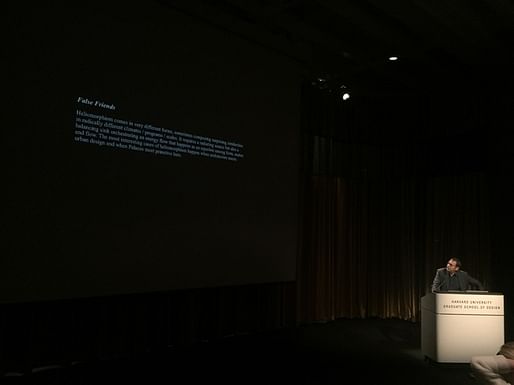
Day one of Heliomorphism, the inaugural conference convened by the new research arm of the Harvard Graduate School of Design’s Office for Urbanization, ended with Thom Mayne of Morphosis Architects finally breaking through the jargon and superficiality of the topic at hand. The theme of the environment, solar performance along with sustainability were all absorbed and raised to the echelon of where they should exist; as already built in qualities of any project, not a topic or excuse for architectural exuberance. Thom Mayne’s ability to recognize and exploit this only provided further proof of the scale, method, and nature of his work as worthy of his recognition and role as a leader in the discipline.
Sadly, during the second and final day of the conference we found ourselves again forcibly located at the epicenter of Ivy League semantic blurring and Copernican alignments. Day one seemed to have fallen into the shadows of the tone and wording at hand. The day was kicked off with a series of presentations by various faculty at the Harvard Graduate school of Design, centered on their respective approaches to the conference’s theme. To name a few, Andrew Witt with “The Heuristic Ecology of Heliomorphism”, Silvia Benedito with “On (de)light”, Sergrio Lopez-Pineiro with “Heliomorphic Urban Space”, and Preston Scott Cohen with “Density and Reflection” all presented their own work, research and understandings while converting them into provocations intended to further the conversations that began on day one.
The wide range of work presented allowed the symposium to discover all the various tangents and possibilities the Office for Urbanization may call its muse or conceptual framework precedent. While the opportunity to invite cross-disciplinary researchers or professionals was lost on a conference founded on research and cross-disciplinary work, it did allow for faculty to be on full display. While the display of work was wide and varied, the lack of a clear restriction only produced a sense of an aimless research blanket, made to encompass the greatest number of current faculty within its reach.
What at first seemed like a negative, that the conference had failed at an effective ‘heliomorphic’ conversation (if there can be one), it did allow for the display of faculty research and design proclivities, which produced a breath of fresh air in a setting which has fended off indexicality so strongly in recent memory. The exposure of the faculty and their processes allowed for a revitalized image of the Design portion of the Graduate School of Design.

Day two ended with a keynote titled, False Friends, by Professor in Residence, Iñaki Ábalos. Ábalos’s work has long been situated directly in the crosshairs of design and environmental factors—a position which he has defended unapologetically—what occurred at his closing keynote was a fantastic surprise. While most would expect that for such a conference, founded on the environmental restriction of solar performance, Ábalos would fully assert his obvious proclivities. But Ábalos, in the same spirit as Mayne the night before, was able to walk us through his work, project by project without relying on his deep knowledge and maps and diagrams of suns. What was presented was the payoff of such work, the design that pulls all the abundant constraints that any architect must maintain. From his domestic work, to his large commercial projects, everything was presented with the sensitivity of both the audience and discipline that was present, if even at points confessing “he liked” certain portions of projects and used them on later ones. No jargon, no excuses of architectural form, just a formidable architect presenting a life’s work done with respect to all implied and necessary responsibilities of the craft.
While the Office for Urbanization’s inaugural conference did not achieve what it set out to do from the outset, it did open a conversation on the role of research—specifically, research at an institution as powerful and historically charged as Harvard. With the resources and possibilities that are inherent in such an institution, we can hope that such an endeavor will add up to shadows of the conference’s bright moments. We only need to look at the clarity and facility of Thom Mayne’s and Iñaki Ábalos’s presentations as potent ways to engage with an audience beyond the walls of the GSD in order to discover partnerships and enhance the pedagogy of the discipline in general. Design Research should strive to discover, exhume, and bring to light the possibilities of such rigorous work and simultaneously clarifying the realm in which it exists; all while accepting its possible failure and chance encounters. As Dean Mohsen Mostafavi pronounced on day one, “ …while I do not promise that this will work...I can promise that it is promising work…” And sometimes, taking that risk is all it takes to find something new, creative and lasting, you just have to be open to it, and that is where the true challenge will come.
No Comments
Block this user
Are you sure you want to block this user and hide all related comments throughout the site?
Archinect
This is your first comment on Archinect. Your comment will be visible once approved.